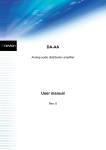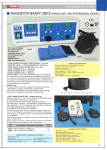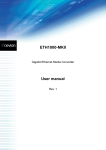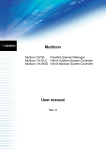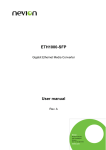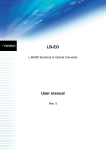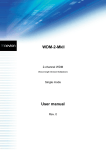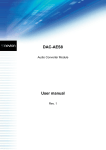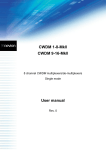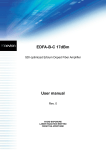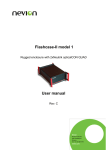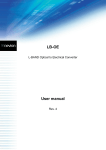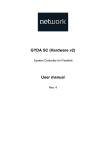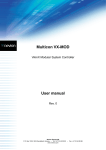Download WOS-2 User manual - AV
Transcript
WOS-2 Wideband Optical Switch User manual Rev. 7 Nevion HQ: Nevion Europe, P.O. Box 1020, 3204 Sandefjord, Norway Tel: +47 33 48 99 99 – Fax: +47 33 48 99 98 – www.nevion.com WOS-2 Rev. 7 Nevion Support Nevion Europe Nevion USA P.O. Box 1020 3204 Sandefjord, Norway Support phone 1: +47 33 48 99 97 Support phone 2: +47 90 60 99 99 1600 Emerson Avenue Oxnard, CA 93033, USA Toll free North America: (866) 515-0811 Outside North America: +1 (805) 247-8560 E-mail: [email protected] See http://www.nevion.com/support/ for service hours for customer support globally. Revision history Current revision of this document is the uppermost in the table below. Rev. 7 Repl. 6 Date 2012-06-11 6 5 5 4 2007-10-30 2007-10-05 4 3 2003.11.13 3 2 2003.08.15 2 1 2002.12.02 1 0 A 0 A - 2002.05.16 2001.10.24 2001.09.13 Sign AJM, JRW AS AS RS RS RS RS RS RS Change description New template , Explained port numbering, 5.1.45.1.5 New front page and removed old logo. Added Materials Declaration and EFUP Corrected GPI desc. for latching trigger types, added information on adjustable delay for the latching tr. types Added specification on multi mode switch Added information of latching trigger types WOS2x1L and WOS-2x2L, configuration examples for APS, information on GYDA web interface and RS422 commands New description of GPI functionality (chapter 4.1) Product release Initial version nevion.com | 2 WOS-2 Rev. 7 Contents Revision history .......................................................................................................... 2 1 Product overview ..................................................................................................... 4 2 Specifications .......................................................................................................... 5 2.1 9/125um Single mode fiber .............................................................................................. 5 2.2 62.5/125um Multi mode fiber ........................................................................................... 5 2.3 Electrical.......................................................................................................................... 5 3 Configuration ........................................................................................................... 6 3.1 Configuration and application examples .......................................................................... 6 3.1.1 Automatic Protection Switching with WOS-2x1L ........................................................... 6 3.1.2 Automatic Protection Switching with WOS-2x2L with monitoring of standby fiber ......... 6 3.1.3 DWDM + Automatic Protection Switching with WOS-2x1L............................................ 6 3.1.4 DWDM + APS with WOS-2x2L and monitoring of standby fiber .................................... 7 4 Connections............................................................................................................. 8 4.1 Connector module ........................................................................................................... 8 4.1.1 Field Modification Instruction, replacement of back plane and PCB. ............................. 8 4.1.2 Applying signals to the connector module ..................................................................... 9 5 Operation ............................................................................................................... 10 5.1 Module status .................................................................................................................10 5.1.1 GPI – Module Status Outputs and switch alarm inputs, non-latching trigger type.........10 5.1.2 GPI – Module Status Outputs and switch alarm trigger inputs, latching trigger type .....10 5.1.3 Front Panel – Status Monitoring ..................................................................................11 5.1.4 Signal path WOS 2x2-(L) .............................................................................................12 5.1.5 Signal path WOS 2x1-(L) .............................................................................................12 5.2 Multicon GYDA System Controller ..................................................................................13 5.3 RS-422 command set .....................................................................................................13 6 Laser safety precautions........................................................................................ 15 General environmental requirements for Nevion equipment..................................... 16 Product Warranty ...................................................................................................... 17 Appendix A Materials declaration and recycling information..................................... 18 A.1 Materials declaration ......................................................................................................18 A.2 Recycling information .....................................................................................................18 EC Declaration of Conformity ................................................................................... 19 nevion.com | 3 WOS-2 Rev. 7 1 Product overview The Flashlink 2x1 Wideband Optical Switch and 2x2 Wideband Optical Switch are fiber optical SPDT (Single Pole Double Throw) changeover modules for use together with the WOS-C1 connector module. Optical output 1 Optical common Optical output 2 Figure 1: Block diagram of the WOS-2x1 and WOS-2x1L Optical input 1 Optical output 1 Optical input 2 Optical output 2 Figure 2: Block diagram of the WOS-2x2 and WOS-2x2L Typical applications for these units are selective routing of optical signal paths without optical-to-electrical conversion and Automatic Protection Switching (APS). The units are controlled via Flashlink GYDA control system or the GPI interface. The optical switches operate in the 2nd and 3rd optical windows (1310nm and 1550nm) The WOS-2x1 has two input/output ports and one common port. The WOS-2x2 has two input ports and two output ports. The product is available in four different versions all delivered with WOS-C1 connector module: WOS-2x1 2x1 Wideband Optical Switch, non-latching trigger type For selective routing WOS-2x2 2x2 Wideband Optical Switch, non-latching trigger type For selective routing WOS-2x1L 2x1 Wideband Optical Switch, latching trigger type For APS WOS-2x2L 2x2 Wideband Optical Switch, latching trigger type For APS nevion.com | 4 WOS-2 Rev. 7 2 Specifications 2.1 9/125um Single mode fiber Optical wavelength: 2nd & 3rd opt. windows (1290-1570nm) Insertion loss: 1.4dB typ, max 2.1dB incl. connectors Connector return loss: >40dB w/SM fiber Cross-talk: <-80dB Repeatability: +/- 0.01dB Durability: 10 000 000 cycles Switching time: <50ms typ. Switching time, latching versions: <200ms typ. Connector: SC/UPC 2.2 62.5/125um Multi mode fiber Optical wavelength: 2nd opt. window (1310nm) Insertion loss: 1.4dB typ, max 2.1dB incl. connectors Connector return loss: >20dB w/SM fiber Cross-talk: <-80dB Repeatability: +/- 0.01dB Durability: 10 000 000 cycles Switching time: <50ms typ. Switching time, latching versions: <200ms typ. Connector: SC/UPC 2.3 Electrical Power: +5V DC / 1W Control: Control system for access to setup and module status with BITE (Built-In Test Equipment). nevion.com | 5 WOS-2 Rev. 7 3 Configuration 3.1 Configuration and application examples 3.1.1 Automatic Protection Switching with WOS-2x1L Figure 3: Possible setup for APS functionality, standby fiber is not monitored. 3.1.2 Automatic Protection Switching with WOS-2x2L with monitoring of standby fiber Figure 4: APS, with monitoring of standby fiber, main position. Figure 5: APS, with monitoring of standby fiber, standby position 3.1.3 DWDM + Automatic Protection Switching with WOS-2x1L Figure 6: DWDM with APS, without monitoring of standby fiber, main position. nevion.com | 6 WOS-2 Rev. 7 3.1.4 DWDM + APS with WOS-2x2L and monitoring of standby fiber Figure 7: DWDM with APS, with monitoring of standby fiber, main position. Figure 8: DWDM with APS, with monitoring of standby fiber, standby position. nevion.com | 7 WOS-2 Rev. 7 4 Connections 4.1 Connector module Overview of the WOS-C1 connector module for 2x1 switch configuration Overview of the WOS-2x2 connector module for 2x2 switch configuration 4.1.1 Field Modification Instruction, replacement of back plane and PCB. This Field Modification Instruction from Nevion shows how to replace the back plane on the Flashlink frame. For questions please contact [email protected] 1. If there is installed a board in the actual slot from earlier, carefully remove this board first. 2. Carefully remove all 4 screws (2 screws if a blank back plane is mounted) from the back plane to be replaced. 3. Insert the new back plane carefully. Use your business card (or another suitable card), as shown in figure below, to avoid that the EMC shield is damaged when inserting the new back plane. 4. Before tightening the screws, use one of your fingers to force the back plane to the bottom of the frame as shown above. Tighten the 2 screws at the bottom at the back plane first. This is to avoid mismatch between the connector on the back plane and the PCB. nevion.com | 8 WOS-2 Rev. 7 5. When inserting the new module for the first time, make sure that the connector on the PCB aligns with connector on the back plane. NOTE: The PCB shall enter the back plane connector easily 6. If a module is placed in the position left to the module (as seen from the rear), a rubber plug must replace the spring-loaded plastic shield of the fiber adapter. 4.1.2 Applying signals to the connector module The optical connection is an SC/UPC connector with a return loss better than 40dB typ. According to SMPTE specifications, the return loss shall be better than 26 dB. WOS-2x1 and WOS-2x1L: WOS-2x2 and WOS-2x2L: Conn. mod. port Switch port Conn. mod. port Switch port OPT 1 Not used OPT 1 Input 1 OPT 2 Output 1(*) OPT 2 Output 1 OPT 3 Common OPT 3 Input 2 OPT 4 Output 2(*) OPT 4 Output 2 (*) Can also be used as input port, meaning that both 2x1 and 1x2 functionality can be implemented. nevion.com | 9 WOS-2 Rev. 7 5 Operation 5.1 Module status The status of the module can be monitored in four ways. 7. GPI at the rear of the sub-rack. 8. LEDs at the front of the sub-rack. 9. GYDA-SC controller. 10. Directly accessing the RS-422 bus. Of these four, the GPI and the LEDs are mounted on the module itself, whereas the GYDASC controller is a separate module giving access to remote monitoring of the status of the card through either a web interface or SNMP. The functions of the GPI and the LEDs are described in sections 4.1 to 4.3. The GYDA-SC controller is described in section 4.4. The commands the modules will respond to over the RS-422 bus, can be found in section 4.5. 5.1.1 GPI – Module Status Outputs and switch alarm inputs, non-latching trigger type These outputs can be used for wiring up alarms for third party control systems. The GPI output is an open collector output, sinking to ground when an alarm is triggered. The GPI outlet is shown in figure 5. The connector used is RJ-45. Max output current: 100mA Max output voltage: 30V WOS-2x1/WOS-2x2 GPI pinning: Signal Status Standby Ground Name General error status for the module Alarm when switch in standby mode Switch to standby mode Switch to standby mode Switch to standby mode 0 volt pin Pin # Pin 1 Pin 2 Pin 5 Pin 6 Pin 7 Pin 8 Input/Output Output Output Input Input Input Mode Open Collector Open Collector 0V= standby 5V= main 0V The switch is set in standby mode by sinking pin5, pin6 or pin7 to ground. Pin6 and pin7 are hardwired as logical OR. Figure 9: GPI Outlet 5.1.2 GPI – Module Status Outputs and switch alarm trigger inputs, latching trigger type These outputs can be used for wiring up alarms for third party control systems. The GPI output is an open collector output, sinking to ground when an alarm is triggered. The GPI outlet is shown in figure 6. The connector used is RJ-45. nevion.com | 10 WOS-2 Rev. 7 Max output current: 100mA Max output voltage: 30V WOS-2x1/WOS-2x2 GPI pinning: Signal Status Standby Ground Name General error status for the module Alarm when switch in standby mode Switch to standby mode Reset switch to main position Reset switch to main position 0 volt pin Pin # Pin 1 Pin 2 Pin 5 Pin 6 Pin 7 Pin 8 Input/Output Output Output Input Input Input Mode Open Collector Open Collector 0V= standby 5V= main 0V The switch is set in standby mode by sinking pin5 to ground. Pin6 and pin7 are hardwired as logical OR and when either is sunk to ground, they will reset the latching switch to main position. Resetting can also be done with GYDA system controller Figure 10: GPI Outlet 5.1.3 Front Panel – Status Monitoring The status of the module can be easily monitored visually by the LEDs at the front of the module. The LEDs are visible through the front panel as shown in Figure 9 Figure 11: Diode overview of WOS-2x1(L)/WOS-2x2(L) Both WOS-2x1(L) and WOS-2x2(L) have 2 LEDs each showing a status corresponding to the GPI outputs. Diode \ state Status Red LED Module is faulty Main/standby Switch in standby position Green LED Module is OK Module power is OK Switch in main position No light Module has no power nevion.com | 11 WOS-2 Rev. 7 5.1.4 Signal path WOS 2x2-(L) Optical input 1 Optical output 1 Optical input 2 Optical output 2 Figure 12: Card configured to main Optical input 1 Optical output 1 Optical input 2 Optical output 2 Figure 13: Card configured to backup Optical input 1 Optical output 1 Optical input 2 Optical output 2 Figure 14: Card without power 5.1.5 Signal path WOS 2x1-(L) Optical output 1 Optical com. Optical output 2 Figure 15: Card configured to main Optical output 1 Optical com. Optical output 2 Figure 16: Card configured to backup Optical output 1 Optical com. Optical output 2 Figure 17: Card without power nevion.com | 12 WOS-2 Rev. 7 5.2 Multicon GYDA System Controller This card can be controlled and monitored from Multicon Gyda. The status of the switch and the power supply can be monitored, while the switch can be changed from the config pan. Figure 18: Main page Figure 19: Config page 5.3 RS-422 command set All commands follow the flashlink protocol, and can be used for direct access to the modules without use of the GYDA-SC, or for third-party control system integration. The flashlink nevion.com | 13 WOS-2 Rev. 7 protocol can be found on our web page http://nevion.com Command Response ? See protocol description main OK standby OK stat Vcc=… One of the following: mode: main mode: standby mode: standby (gpi) Relay failure Comment The "hello" command Switch to main position Switch to standby position Module status +5V voltage monitoring Main position Standby position Standby pos. GPI active Relay failure nevion.com | 14 WOS-2 Rev. 7 6 Laser safety precautions Guidelines to limit hazards from laser exposure. All the available EO units in the flashlink range include a laser. Therefore this note on laser safety should be read thoroughly. The lasers emit light at wavelengths around 1310 nm or 1550 nm. This means that the human eye cannot see the beam, and the blink reflex can not protect the eye. (The human eye can see light between 400 nm to 700 nm). A laser beam can be harmful to the human eye (depending on laser power and exposure time). Therefore: BE CAREFUL WHEN CONNECTING / DISCONNECTING FIBER PIGTAILS (ENDS). NEVER LOOK DIRECTLY INTO THE PIGTAIL OF THE LASER/FIBER. NEVER USE MICROSCOPES, MAGNIFYING GLASSES OR EYE LOUPES TO LOOK INTO A FIBER END. USE LASER SAFETY GOGGLES BLOCKING LIGHT AT 1310 nm AND AT 1550 nm Instruments exist to verify light output power: Power meters, IR-cards etc. Flashlink features: All the laser module cards in the Flashlink product range are Class 1 laser products according to IEC 825-1 1993, and class I according to 21 CFR 1040.10 when used in normal operation. More details can be found in the user manual for the FR-2RU-10-2 frame. Maximum output power*: 5 mW. Operating wavelengths: > 1270 nm. * Max power is for safety analysis only and does not represent device performance. nevion.com | 15 WOS-2 Rev. 7 General environmental requirements for Nevion equipment 1. 2. - The equipment will meet the guaranteed performance specification under the following environmental conditions: Operating room temperature range: 0°C to +50°C Operating relative humidity range: <90% (non-condensing) The equipment will operate without damage under the following environmental conditions: Temperature range: -10°C to +55°C Relative humidity range: <95% (non-condensing) nevion.com | 16 WOS-2 Rev. 7 Product Warranty The warranty terms and conditions for the product(s) covered by this manual follow the General Sales Conditions by Nevion, which are available on the company web site: www.nevion.com nevion.com | 17 WOS-2 Rev. 7 Appendix A Materials declaration and recycling information A.1 Materials declaration For product sold into China after 1st March 2007, we comply with the “Administrative Measure on the Control of Pollution by Electronic Information Products”. In the first stage of this legislation, content of six hazardous materials has to be declared. The table below shows the required information. Toxic or hazardous substances and elements 組成名稱 Part Name WOS-2x1 / WOS-2x2 鉛 汞 镉 六价铬 多溴联苯 Lead Mercury Cadmium Hexavalent Polybrominated (Pb) (Hg) (Cd) Chromium biphenyls (Cr(VI)) (PBB) O O O O O 多溴二苯醚 Polybrominated diphenyl ethers (PBDE) O O: Indicates that this toxic or hazardous substance contained in all of the homogeneous materials for this part is below the limit requirement in SJ/T11363-2006. X: Indicates that this toxic or hazardous substance contained in at least one of the homogeneous materials used for this part is above the limit requirement in SJ/T11363-2006. This is indicated by the product marking: A.2 Recycling information Nevion provides assistance to customers and recyclers through our web site http://www.nevion.com/. Please contact Nevion’s Customer Support for assistance with recycling if this site does not show the information you require. Where it is not possible to return the product to Nevion or its agents for recycling, the following general information may be of assistance: Before attempting disassembly, ensure the product is completely disconnected from power and signal connections. All major parts are marked or labeled to show their material content. Depending on the date of manufacture, this product may contain lead in solder. Some circuit boards may contain battery-backed memory devices. nevion.com | 18 EC Declaration of Conformity MANUFACTURER Nevion AUTHORIZED REPRESENTATIVE (Established within the EEA) Not applicable MODEL NUMBER(S) WOS-2x1 / WOS-2x2 DESCRIPTION Wideband Optical Switch DIRECTIVES this equipment complies with Low voltage (EU Directive 2006/95/EC) EMC (EU Directive 2004/108/EC) RoHS (EU Directive 2002/95/EC) 1 China RoHS WEEE (EU Directive 2002/96/EC) REACH HARMONISED STANDARDS applied in order to verify compliance with Directive(s) EN 55103-1:1996 EN 55103-2:1996 EN 60950-1:2006 TEST REPORTS ISSUED BY Notified/Competent Body Report no: Nemko TECHNICAL CONSTRUCTION FILE NO Not applicable YEAR WHICH THE CE-MARK WAS AFFIXED 2012 TEST AUTHORIZED SIGNATORY MANUFACTURER AUTHORIZED REPRESENTATIVE (Established within EEA) Date of Issue 2012-06-11 Place of Issue Not applicable 1 Name Thomas Øhrbom Position VP of Business Support Systems, Nevion (authorized signature) Administration on the Control of Pollution Caused by Electronic Information Products Nevion HQ: Nevion Europe, P.O. Box 1020, 3204 Sandefjord, Norway Tel: +47 33 48 99 99 – Fax: +47 33 48 99 98 – www.nevion.com Sandefjord, Norway





















